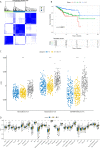Identification of Tumor Microenvironment-Related Alternative Splicing Events to Predict the Prognosis of Endometrial Cancer
- PMID: 33996564
- PMCID: PMC8116885
- DOI: 10.3389/fonc.2021.645912
Identification of Tumor Microenvironment-Related Alternative Splicing Events to Predict the Prognosis of Endometrial Cancer
Abstract
Background: Endometrial cancer (EC) is one of the most common female malignant tumors. The immunity is believed to be associated with EC patients' survival, and growing studies have shown that aberrant alternative splicing (AS) might contribute to the progression of cancers.
Methods: We downloaded the clinical information and mRNA expression profiles of 542 tumor tissues and 23 normal tissues from The Cancer Genome Atlas (TCGA) database. ESTIMATE algorithm was carried out on each EC sample, and the OS-related different expressed AS (DEAS) events were identified by comparing the high and low stromal/immune scores groups. Next, we constructed a risk score model to predict the prognosis of EC patients. Finally, we used unsupervised cluster analysis to compare the relationship between prognosis and tumor immune microenvironment.
Results: The prognostic risk score model was constructed based on 16 OS-related DEAS events finally identified, and then we found that compared with high-risk group the OS in the low-risk group was notably better. Furthermore, according to the results of unsupervised cluster analysis, we found that the better the prognosis, the higher the patient's ESTIMATE score and the higher the infiltration of immune cells.
Conclusions: We used bioinformatics to construct a gene signature to predict the prognosis of patients with EC. The gene signature was combined with tumor microenvironment (TME) and AS events, which allowed a deeper understanding of the immune status of EC patients, and also provided new insights for clinical patients with EC.
Keywords: alternative splicing; endometrial cancer; gene signature; prognosis; tumor microenvironment.
Copyright © 2021 Liu, Liu, Liu, Song, Wang, Wu, Yu and Cai.
Conflict of interest statement
The authors declare that the research was conducted in the absence of any commercial or financial relationships that could be construed as a potential conflict of interest.
Figures








Similar articles
-
The pattern of alternative splicing in lung adenocarcinoma shows novel events correlated with tumorigenesis and immune microenvironment.BMC Pulm Med. 2021 Dec 6;21(1):400. doi: 10.1186/s12890-021-01776-0. BMC Pulm Med. 2021. PMID: 34872548 Free PMC article.
-
Comprehensive characterization of the alternative splicing landscape in ovarian cancer reveals novel events associated with tumor-immune microenvironment.Biosci Rep. 2022 Feb 25;42(2):BSR20212090. doi: 10.1042/BSR20212090. Biosci Rep. 2022. PMID: 35137909 Free PMC article.
-
Identification of EMT-Related Gene Signatures to Predict the Prognosis of Patients With Endometrial Cancer.Front Genet. 2020 Dec 2;11:582274. doi: 10.3389/fgene.2020.582274. eCollection 2020. Front Genet. 2020. PMID: 33343628 Free PMC article.
-
Identification of prognostic alternative splicing events related to the immune microenvironment of hepatocellular carcinoma.Mol Med. 2021 Apr 8;27(1):36. doi: 10.1186/s10020-021-00294-3. Mol Med. 2021. PMID: 33832428 Free PMC article.
-
New Insights into Endometrial Cancer.Cancers (Basel). 2021 Mar 24;13(7):1496. doi: 10.3390/cancers13071496. Cancers (Basel). 2021. PMID: 33804979 Free PMC article. Review.
Cited by
-
Identification of Alternative Splicing-Related Genes CYB561 and FOLH1 in the Tumor-Immune Microenvironment for Endometrial Cancer Based on TCGA Data Analysis.Front Genet. 2022 Jun 28;13:770569. doi: 10.3389/fgene.2022.770569. eCollection 2022. Front Genet. 2022. PMID: 35836577 Free PMC article.
-
Prognostic importance of splicing-triggered aberrations of protein complex interfaces in cancer.NAR Genom Bioinform. 2024 Sep 26;6(3):lqae133. doi: 10.1093/nargab/lqae133. eCollection 2024 Sep. NAR Genom Bioinform. 2024. PMID: 39328266 Free PMC article.
-
Immune cell infiltration as a prognostic factor in endometrial cancer: a meta-analysis.Am J Cancer Res. 2025 Mar 15;15(3):1335-1345. doi: 10.62347/BXZM8857. eCollection 2025. Am J Cancer Res. 2025. PMID: 40226477 Free PMC article.
-
The potential impact of RNA splicing abnormalities on immune regulation in endometrial cancer.Cell Death Dis. 2025 Mar 3;16(1):148. doi: 10.1038/s41419-025-07458-7. Cell Death Dis. 2025. PMID: 40032844 Free PMC article. Review.
-
Comprehensive characterization of 11 prognostic alternative splicing events in ovarian cancer interacted with the immune microenvironment.Sci Rep. 2022 Jan 19;12(1):980. doi: 10.1038/s41598-021-03836-1. Sci Rep. 2022. PMID: 35046435 Free PMC article.
References
LinkOut - more resources
Full Text Sources
Other Literature Sources
Research Materials

